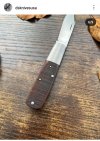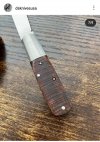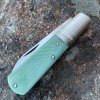Sean Yaw
Gold Member
- Joined
- Feb 26, 2019
- Messages
- 417
The BladeForums.com 2024 Traditional Knife is ready to order! See this thread for details:
https://www.bladeforums.com/threads/bladeforums-2024-traditional-knife.2003187/
Price is $300 $250 ea (shipped within CONUS). If you live outside the US, I will contact you after your order for extra shipping charges.
Order here: https://www.bladeforums.com/help/2024-traditional/ - Order as many as you like, we have plenty.
Stacy are you saying the technique I shared is wrong? It seems like maybe you are but I could be wrong. I'm all eyes and ears to see an example of your technique. I love to learn new tricks and would add that there generally is no wrong way. Only different ways. That said, I'll share an example of my recommended technique which was passed on to me from someone well respected in the slip joint crowd. Knife was made by Don Southard, I shared the disk technique with him. Looks like it worked out pretty good to me.Checkering file will do it best.
A circular saw or disc sander will make curved lines, not parallel straight lines. They won't be at the right angle, either.


That assumes I can reliably push a file in a straight line. Big assumption.I think that a checkeringfile will give an to even result and not the saw cut result.
There is no wrong or right way. Your bone looks nothing like what the OP posted, though.Stacy are you saying the technique I shared is wrong? It seems like maybe you are but I could be wrong. I'm all eyes and ears to see an example of your technique. I love to learn new tricks and would add that there generally is no wrong way. Only different ways. That said, I'll share an example of my recommended technique which was passed on to me from someone well respected in the slip joint crowd. Knife was made by Don Southard, I shared the disk technique with him. Looks like it worked out pretty good to me.
View attachment 2163717
View attachment 2163718
Agreed, I actually mentioned the point of no wrong way in my last post and again not my bone just an example of the method I mentioned and obviously a maker can craftly position the lines at different angles for the end result. I genuinely would like to see an example of sawcut bone that has been done with a checkering file. Surely if someone is recommending it they would have an example to illustrate the technique.There is no wrong or right way. Your bone looks nothing like what the OP posted, though.
i believe you are correct .. when you cut something with a circular blade you get marks like those in the first picture..The original vintage sawcut bone was cut on a table saw type setup with a fairly small diameter blade (old school blades, not the modern chisel point variety). Variations in the sharpened edges are what gave you that nice uneven grooved appearance. I think (not positive) that the GEC bone is done on an indexable milling setup, similar to what the shops use to cut the nail file grooves in their blades.
Eric

Beautiful knife.I tried 36 grit paper on a 12" disc, band saw, and checkering file. I really liked the look of the 12" disc, but wanted deeper marks. It also looked better on darker bone than lighter stuff. In the end, I went with the checkering file and the result was good enough. I don't think it will be the only way I try it in the future, but good enough for me for a first shot.
View attachment 2171754
